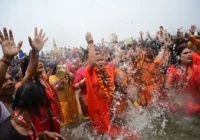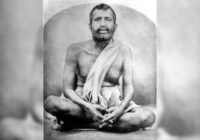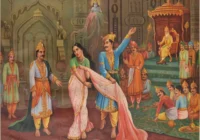My wife and I are not religious. Monica was raised as a Gujarati Hindu while I grew up in an orthodox Parsi family in Ahmedabad, India. Formal religion — hers or mine — plays no role in our day-to-day lives. Both of us studied in the same convent elementary school and then in a Jesuit college, before she went on to medical college and I joined the Indian Institute of Technology (IIT) Bombay. Marrying her in 1972 was a VERY BIG DEAL in my family, as I was the first one to marry a Parjat (a non-Parsi). After 44 years of marriage, two wonderful sons and four grandchildren, our family has become truly diverse with Polish and Chinese daughters-in-law. Since both of us are officially senior citizens, we decided to take a tour of some of the holiest places for the different Indian religious groups.
I am not an expert on comparative religions, I simply consider myself more of a curious outsider who critically observes the characteristics of each religious practice in India and develops his own impressions.
Old Goa — Basilica of Bom Jesus — Holiest Church for Catholics in India
In early January 2016, the 1970 IIT Bombay batch had its sapphire reunion, an event to celebrate 45 years of our graduation, in Goa. As part of our tour, we visited the Basilica of Bom Jesus, where St. Francis Xavier’s sacred relics lie. Incidentally my high school was named after him. The church was majestically built in the colonial Portuguese days. But the visit was more akin to a tour of St. Patrick’s Cathedral in Manhattan — people in organized groups following a guide speaking in hushed tones with no shoving and pushing going on.
To be honest, the fact that the saint’s body has remained intact did not make a great impression on me. All throughout my school days, there was always an undercurrent of resentment in our mandatory Moral Science class taught by Jesuit Fathers. This might have been due to the fact that the Portuguese and the British imposed Christian faiths on Indians who were primarily Hindu and Muslim. Those feelings from over 50 years ago came flashing back to me as I walked through the basilica.
Amritsar, Punjab — Golden Temple — Holiest Gurdwara for Sikhs in the World
In 2016, we visited the Golden temple twice – first around 10pm on August 26 and then again on the following morning. The temple was surrounded by a large water-filled moat and at night it really glowed like a large Golden structure. There were literally thousands of devoted visitors; more than 95% were Sikh men, women and children. We were all asked to cover our heads, wash our feet and walk barefoot. The caretakers, called sevadars, were polite but quite stern and kept people in check. We saw the Guru Granth Sahib, the holy religious scripture of Sikhism, being ceremoniously taken from the inner sanctum, called Harmandir, to the Akal Takht, the seat of power, for the night. Dozens of religious Sikhs wanted to touch the Palkhi, the carrier in which the Holy Book was placed, in order to get blessings. Walking around the entire square was a memorable experience.
The following morning, we stood in a long line to get into the inner sanctum and were able to partake in some excellent sweet halwa given to everyone as prasad, an offering to the gods. I found remarkable that during our two visits to the Golden Temple, no one ever asked for alms. Also, considering the large crowds, the place was remarkably clean. Most of the services and management at the temple was conducted by Sikh volunteers. This was an exceptional feature not seen at other religious places we visited. I was really touched by the selflessness shown by the Sikh community.
Varanasi aka Banares, Uttar Pradesh — The Holiest of the Seven Sacred Cities in Hinduism and Sarnath — One of The Holiest Places for Buddhists
From the Golden Temple in Amritsar we made our way to the ancient city of Varanasi, which many Hindus deem the holiest of cities. We arrived in the city on August 28. Just a couple of days earlier the Ganga River had flooded over its banks making it impossible to climb down the ghats, its flight of steps. Our day started with a chaotic drive through the heart of dirty Varanasi towards the famous Kashi Vishwanath Shiva temple. After parking the car, we walked over a mile through narrow and shockingly filthy lanes. It was sad to see the emaciated cows eating garbage and plastic wrappers. To call a cow “holy” and then treat the poor animal in such a disgusting manner is almost criminal.
At first the police guards outside the Kashi Vishwanath temple would not allow Monica and myself to enter the temple. Luckily our guide intervened and we could visit the temple on condition that we left our US passports with the inspectors. Before entering the temple, we had to buy some items for the puja, an offering to the gods, in order to make the merchant who was guarding our shoes and other belongings happy. The Shiva Mandir’s inner sanctum was rather underwhelming with all the worshippers hustled in and out within minutes. The place was unkempt and not up to my expectations. Or maybe it was just my skepticism about religion that made me focus on the negatives.
In my opinion, Varanasi takes the first prize in being the filthiest city in India with little or no civic sense. But to my great surprise whenever we mentioned this fact to the locals, they looked amazed and pointed out that the city had never had an epidemic of malaria or plague like other Indian cities. Even many of the educated folks sincerely believed that Ganga Maiya, which literally means Mother Ganges in the Hindi language, took care of all these issues as a divine matter.
The next day we visited Sarnath, only about 13 kilometers from Varanasi. It remains one of the holiest places in Buddhism. The temple receives an extremely large number of tourists from Southeast Asia and particularly the Sinhalese Buddhists from Sri Lanka. Unlike Hindu temples, the Buddhist place of worship was austere, clean and neat. There was an aura of peace and quiet we had never experienced on previous occasions. We also stopped by the Dhamek and Chaukhandi Stupas – one of them erected by Emperor Ashoka who ruled in the 3rd century BCE. These commemorative monuments are massive structures and a real archeological rarity.
Jaipur to Ajmer to Visit Pushkar — A Rare Hindu Brahma Temples and the Holy Muslim Ajmer Sharif Dargah
We continued our 2016 pilgrimage through North Central India to Jaipur, Rajasthan. On August 31 we reached Pushkar about 14 kilometers from Ajmer and walked for quite a while to one of the five most sacred dhams, pilgrimage sites, at the Pushkar Lake. The Brahma temple that we visited was built in the 14th century. According to legend, there are only a few Brahma temples in India because the god’s wife, blinded by jealousy, cursed him that he wouldn’t be worshiped anymore on earth. At this site we had quite an unpleasant adventure with the pujari, the temple priest in charge of the puja. When we refused to pay the entire big sum of money he had asked for to perform the ritual, the priest attacked us claiming that our children and grandchildren would suffer as a result. Needless to say, I gave in to his request, but the whole experience left me quite disillusioned with the significance of religious ceremonies.
After Pushkar, we drove to Ajmer Sharif Dargah of Moinuddin Chishti, a revered Muslim shrine visited by over 100,000 pilgrims a day. Despite being quite crowded, the place was surprisingly clean like the Sikh Golden Temple. My late mother- and fatheri-in-law who were Hindus, used to send money through their Muslim servants to offer a chaddar, a sheet offered in devotion, at the Ajmer Sharif Dargah. In honor of their beliefs, my wife requested one of the Muslim priests to conduct a short prayer ceremony and asked him about the charge. Unlike the aggressive Hindu priest at Pushkar, the Maulvi replied that we could offer whatever sum we wished. For an offering of 2,000 rupees, they prepared an elaborate wicker basket with flowers and fruits and I had to carry it on my head into the inner sanctum of the Dargah. It was an interesting and enjoyable experience. We also saw a huge pot in which rice and dal were cooked. The food was to be distributed to the poor outside the Dargah.
Tirupati via Hyderabad — Tirumala Venkateswara Temple — Holiest Temple in South India
On September 1 we flew to Tirupati, Andhra Pradesh. After checking into the hotel, we visited the fanciest Sari Palace in town. So, while chatting to the shop owner, we accidentally learned that it would be rather difficult to do a Tirupati Temple Darshan without prior approval from a local official. But everything has a price in India. We were informed that if we gave a substantial baksheesh, a tip, to a certain individual, we would be given immediate access to the world-famous Tirumala Venkateswara Temple’s inner sanctum. For this special visit, called darshan, women have to wear a sari or a long plain churidar dress, with tight fitting trousers, while men wear a dhoti and angavastram, a long sarong and a shoulder cloth.
So we purchased the necessary clothes and then patiently waited for a call in our hotel room. At around 9.30pm an inspector with the Vigilance and Anti-Corruption Department with the Tirumala Tirupati Devasthanams (TTD) announced he would be our guide and was willing to take us for a very special darshan that same night. We quickly dressed with the right apparel and followed him. Everything about the temple was highly organized in a businesslike manner. We cut across huge lines of pilgrims because of our special dispensation and were allowed to stop and observe the deity of Lord Venkateswara for well over five minutes, whereas others were hustled out with no more than 30 seconds of darshan.
All of this special dispensation came at a heavy price. The next day we were asked to give the inspector who had arranged our visit, a princely sum of 10,000 rupees. Our driver got visibly upset because we were treated as “foreigners.” He claimed that we had been overcharged and that the inspector had taken full advantage of our ignorance. Later that day we also visited a couple of other temples and everywhere the business approach was the same. It felt more like going to a shopping mall than to a temple. No wonder that the TTD Trust receives over $30 million just in admission tickets and the sale of laddus, sweets, generates a staggering revenue stream exceeding $10 million. All other donations are probably 100 times more than the numbers mentioned above. The TTD trust does run several universities and claims to conduct many charitable activities.
Bombay — Zoroastrian Atash Behram — The End of Our India Pilgrim Tour
When Islam came to Persia, some Zoroastrians fled to India. Since then, members of this community have been called Parsis in honor of the land of their origin. In Bombay, I decided to complete our pilgrim tour by visiting all four of the holiest Parsi fire temples called Atash Behrams, which means the fire of victory. This is the highest grade of a fire that can be placed in a Zoroastrian fire temple as an eternal flame. The other two lower graded fires are Atash Adaran and below is the Atash Dadfah. These three grades signify the degree of reverence and dignity these are held in.
As I mentioned at the beginning, my wife was raised as a Hindu and non-Parsis are not allowed to enter these places of worship, therefore on September 4, 2016, I visited on my own the Banaji Atash Behram (AB) on Charni road in Bombay, followed by the Wadiaji AB in Dhobi Talao, then the Anjuman AB also in Dhobi Talao and the last Dadyseth AB in Fanaswadi, Chira Bazaar area.
What came as a great shock to me was, unlike all the other crowded temples we had visited, the ultra neat and clean Atash Behrams were almost empty and there were more priests than lay people. I am a 67-year-old senior citizen, but the vast majority of the Parsis praying in these temples appeared to be much older than me. All the Hindu, Christian, Sikh and Muslim places of worship were teeming with young children, whereas in the Atash Behrams I didn’t see any. It is a known fact that the Parsis are a dying breed in India. With our intolerance of not admitting any non-Parsis into our fire temples and the most outrageously offensive policy of disbarring a Parsi female who marries a non-Parsi in India from entering our fire temples and treating her children likewise, the Zoroastrian Parsi population will continue to diminish rapidly. Now there are only 53,000 Parsis remaining in India and about 110,000 worldwide. At this rate, Parsis will be wiped out in 50 to 75 years unless the orthodox extremists lose their stranglehold on the fast-declining community.
More Confused Than Ever
Indian society is quite religious. In daily life, religion often plays a big role in people’s lives. Many people make pilgrimages to holy sites and places of worship to thank god/gods, seek blessings and make wishes. I went to places of worship in a spirit of curiosity. I wanted to see if there was something about religion that I had been missing over all these years.
One striking thing occurred to me. There is great spiritual energy among the people who go on pilgrimages. Each of them have their own hopes, desires and beliefs. Yet while the places of worship appeared to be lush with cash, the poor do not seem to benefit from this wealth. Their religiosity benefits the places of worship and the custodians of such places.
As I said earlier, I went on this pilgrim tour with an open mind. I hoped to escape my state of “confused atheism,” achieve a deeper understanding of the religious practices and, as a result, become a better person. However, the two weeks of traveling the length and breadth of India increased my disenchantment and disillusionment with religion. Thanks to my 2016 pilgrimage, I remain even more of a confused atheist.
(This article was edited by Senior Editor Francesca Julia Zucchelli.)
The views expressed in this article are the author’s own and do not necessarily reflect Fair Observer’s editorial policy.
Support Fair Observer
We rely on your support for our independence, diversity and quality.
For more than 10 years, Fair Observer has been free, fair and independent. No billionaire owns us, no advertisers control us. We are a reader-supported nonprofit. Unlike many other publications, we keep our content free for readers regardless of where they live or whether they can afford to pay. We have no paywalls and no ads.
In the post-truth era of fake news, echo chambers and filter bubbles, we publish a plurality of perspectives from around the world. Anyone can publish with us, but everyone goes through a rigorous editorial process. So, you get fact-checked, well-reasoned content instead of noise.
We publish 2,500+ voices from 90+ countries. We also conduct education and training programs
on subjects ranging from digital media and journalism to writing and critical thinking. This
doesn’t come cheap. Servers, editors, trainers and web developers cost
money.
Please consider supporting us on a regular basis as a recurring donor or a
sustaining member.
Will you support FO’s journalism?
We rely on your support for our independence, diversity and quality.







Comment